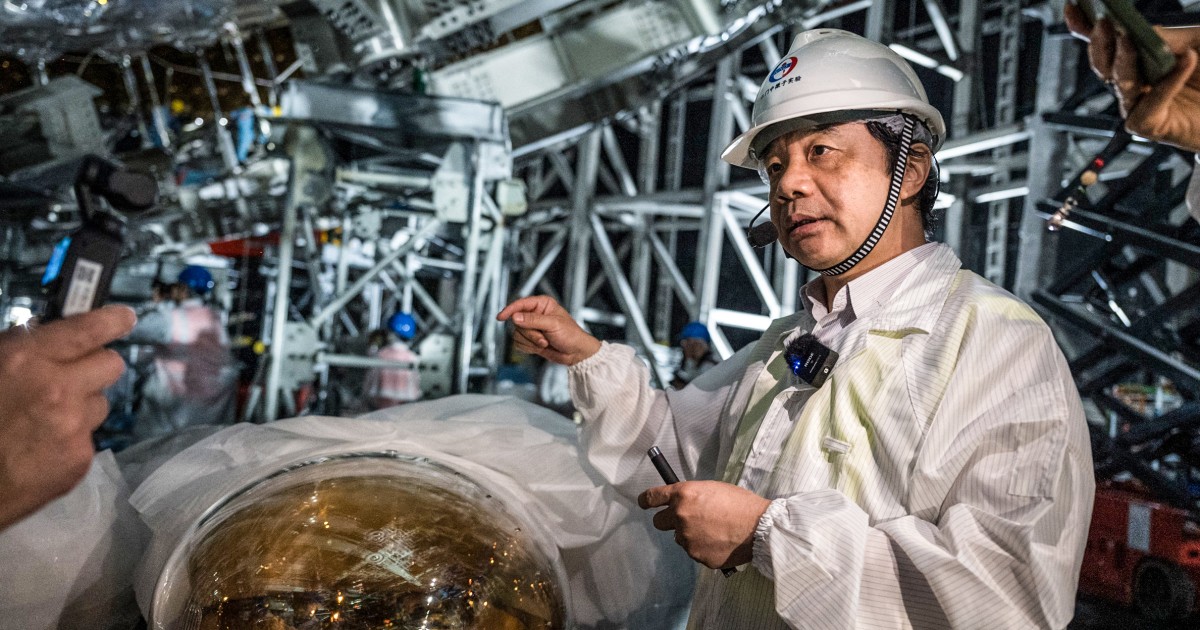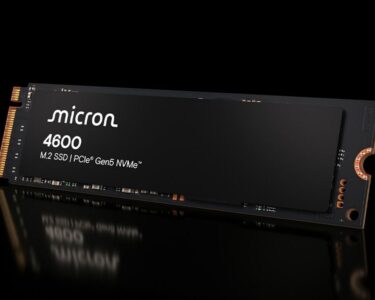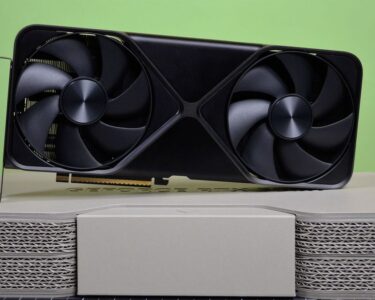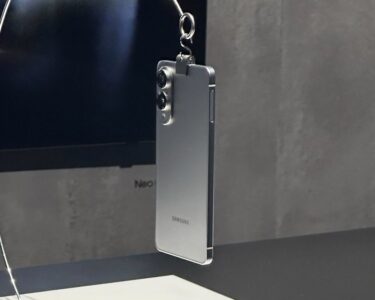Trillions of neutrinos pass through our bodies every second. The sun produces them through fusion; so do nuclear power plants. Some come from supernova explosions in space. Neutrinos pair with antineutrinos, which scientists think mirror their behavior.
So JUNO is designed to capture antineutrinos — specifically, those emitted from two nuclear power plants about 33 miles away from the observatory.
JUNO’s sphere, which is 13 stories tall, will be filled with a special liquid called “scintillator” and submerged in a cylinder of purified water, said Wang Yifang, the project leader and director of China’s Institute of High Energy Physics.
When antineutrinos pass into the liquid, they’ll trigger chemical processes that will produce a brief glimpse of light, which can be captured by sensors lining the sphere.
“The event will trigger a flash lasting only about 5 nanoseconds, which we hope to capture with the thousands of photomultiplier tubes surrounding the sphere,” Wang said, clad in a hard hat as workers behind him installed the tubes. “We hope to catch 60 events a day.”
Thanks to that approach, JUNO should be able to measure differences in the masses of antineutrinos about 10 times better than previous equipment.
The first of three new neutrino observatories
JUNO is part of China’s ambitious efforts to become a global science powerhouse. In a speech this year, President Xi Jinping laid out plans to transform the country into a science and technology giant by 2035.
JUNO is expected to be the first of three next-generation neutrino observatories opening in the next 10 years, which makes it a kind of spearpoint in a new era in physics. In Japan, the Hyper-Kamiokande observatory is scheduled to open in 2027. And a U.S.-backed program called the Deep Underground Neutrino Experiment, or DUNE, calls for a particle accelerator to send a beam of neutrinos underground from Illinois to North Dakota starting in 2031.
The three forthcoming observatories all plan to use different technologies to detect the particles, so they are at once complements and competitors. Each involves sprawling international collaboration designed to propel the field forward, spawn new spinoff technologies and train a new wave of scientists.
“It’s not unlikely that we will observe something unexpected when we turn these experiments on,” said Chris Marshall, an assistant professor of physics at the University of Rochester, who is working on the DUNE project. “Trying to tease out these really complicated effects … is going to require having multiple experiments that are measuring things in different ways.”
To some degree, each observatory’s ability to answer key physics questions will depend on how well researchers are able to work between projects and with one another. But concern is growing among some scientists worldwide that rising geopolitical tensions between the U.S. and China — and the resulting souring of their scientific relationship — could hinder progress.
In recent years, the U.S. has pursued policies designed to prevent Chinese scientists from taking U.S.-based technology to their home country and to prevent China from poaching star science talent.
Wang said that the U.S. denied his visa requests in 2022 and 2023, without explanation, and that it has limited U.S. involvement in JUNO.
“In science, cooperation and competition is good, but it should not be competition only,” he said.
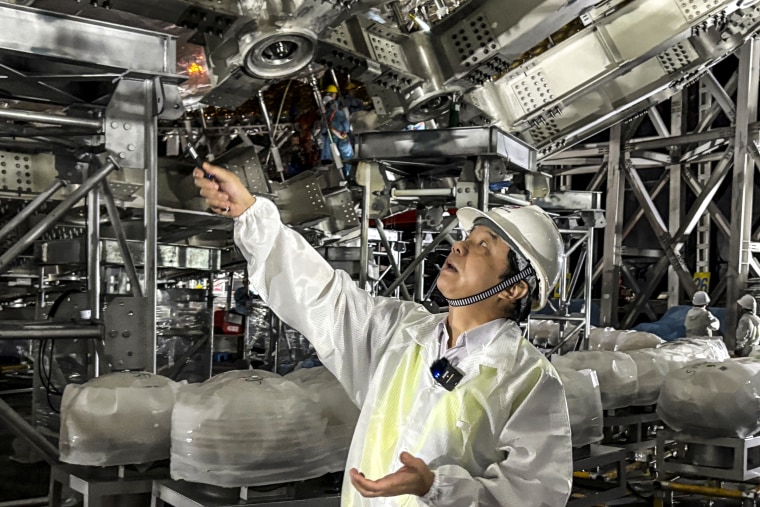
U.S.-based scientists said they’ve noticed new roadblocks to working with Chinese scientists, as well.
“From the U.S. side, it becomes more difficult to obtain funding for collaboration with Chinese colleagues and it has become rather difficult for our Chinese colleagues to obtain U.S. visa,” Patrick Huber, director of Virginia Tech’s Center for Neutrino Physics, said in an email.
Ignacio Taboada, a professor of physics at Georgia Tech who helps lead an existing neutrino observatory at the South Pole, said, “It’s not impossible to collaborate with Chinese scientists — it’s just getting harder and harder.”
Solving the mysteries of neutrinos
Data generated at JUNO could go a long way toward settling key mysteries about how and why neutrinos shape-shift more than other subatomic particles.
Neutrinos can oscillate, or morph, among three so-called “flavors” as they travel — muon, tau and electron. The sun, for example, sends electron neutrinos toward Earth, but sometimes they arrive as muon neutrinos. When neutrinos interact — which happens only rarely — they settle on a particular flavor.
In addition, scientists think that neutrinos travel as one of three different mass states and that the states help determine the likelihood that a neutrino interacts as a particular flavor. But it’s not yet clear which of the states has the most mass.
Scientists also think that neutrinos and antineutrinos might morph differently as they travel and that those differences might be responsible for part of the imbalance in physics between matter and antimatter in the universe.

If so, learning more about the masses and oscillations of neutrinos and antineutrinos could help researchers understand whether the standard model of physics — the rule book for particles and how they interact — is missing pages or whether previously unknown particles or forces might be playing an unseen role.
“Our beautiful theory of reality, the standard model, is not the final theory,” said Sergio Bertolucci, an Italian particle physicist and co-spokesperson for DUNE. “We’ve discovered we need to know more about neutrinos to answer things the standard model cannot answer.”
Wang wants JUNO to win the race to determine the mass hierarchy of neutrinos — before the U.S. and other countries.
“We just want to be good scientists. In science, to be the first is most important. To be second is nothing,” he said. “As a scientist, I can’t just be a follower all the time. I want to have my own.”
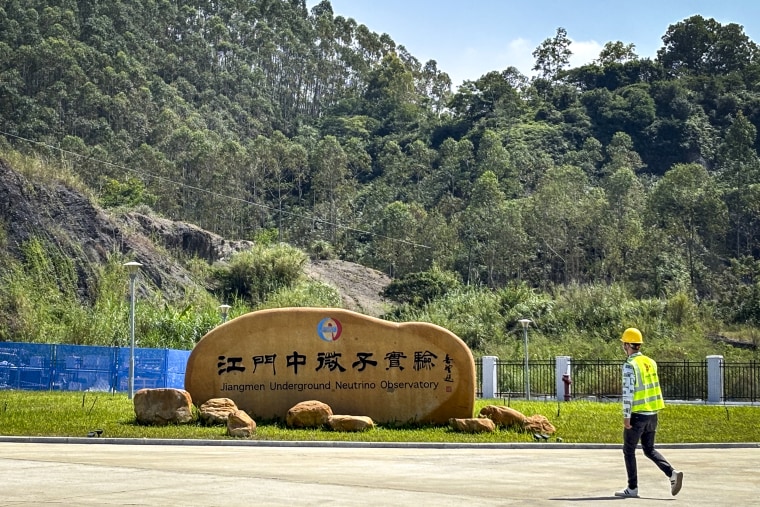
If JUNO explains the story of neutrino masses before DUNE comes online, the U.S.-led project would then be able to measure the question differently and confirm JUNO’s results.
The plan for DUNE is to measure neutrinos as they leave a facility in Illinois, after which they will travel 800 miles through the Earth, where they will be able to interact and oscillate. Once they arrive in South Dakota and can be detected, scientists should be able to compare the mix of neutrino flavors at the start and end of their journey. The project has had delays and cost overruns, however.
“JUNO’s rich dataset, which will be one of a kind … will play a key role in helping us determine the mass ordering before 2030, either on its own or in combination with other experiments,” said Pedro Ochoa-Ricoux, a professor of physics and astronomy at the University of California, Irvine.
Several scientists behind neutrino observatory projects admitted, though, that it’s impossible to predict the practical, earthly benefits of the research. Down the road, they suggested, it could spin off new technologies, drive innovations in data-intensive computing and advance particle accelerator science.
“If you improve a candle, you’ll never make an electric lamp, so you need a step. You need a discontinuity,” said Mary Bishai, a particle physicist at the U.S. Energy Department’s Brookhaven National Laboratory and a co-spokesperson for the DUNE project. “Fundamental research essentially is a generator of discontinuities.”
Wang put it another way, attributing his work to pure curiosity: “I am engaged in ‘useless’ science,” he said.


